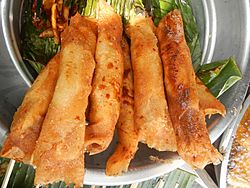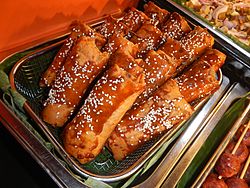Turon (food) facts for kids
  |
|
| Alternative names | Turrón de banana, turrón de plátano, lumpiang saging |
|---|---|
| Type | Snack |
| Place of origin | Philippines |
| Main ingredients | Bananas, brown sugar |
Turon (pronounced too-RON) is a yummy Filipino snack. It's also called lumpiang saging, which means "banana spring roll" in Filipino. This tasty treat is made from thin slices of bananas, usually a type called saba or Cardaba bananas. The banana slices are lightly coated with brown sugar, then wrapped in a thin spring roll wrapper. Finally, they are fried until the wrapper becomes golden and crispy.
Sometimes, turon has other delicious fillings too! The most common extra filling is jackfruit (called langka). But you might also find turon with sweet potato (kamote), mango (mangga), cheddar cheese, or even coconut (niyog).
Even though the name turon sounds a bit like the Spanish word for a candy called turrón, they are completely different! Turon is a crunchy and chewy snack. People in the Philippines often eat it during merienda, which is like a snack time in the afternoon, or as a dessert after a meal.
What is Turon?
Turon is a very popular snack and street food in the Philippines. You can often find it sold by vendors on the streets, right alongside other favorites like banana cue (fried bananas on a stick) and maruya (banana fritters). In Manila, the capital city of the Philippines, turon is one of the most famous street foods. It's easy to buy and eat while you're on the go!
How Turon Started
It's believed that turon first came about in communities in the Philippines that were close to banana farms. When there were too many bananas harvested, the extra fruit would be given to local people. Over time, these extra bananas were turned into turon and sold by the roadside. This made a delicious snack out of surplus fruit.
Turon in Malabon
In a place called Malabon in the Philippines, the word "turón" or "turon" actually means something a little different. There, it refers to a fried dessert wrapped in a lumpia wrapper, but it's filled with sweet mung beans instead of bananas. For the banana-filled version, people in Malabon use the name valencia. Malabon banana turon is often sold as valencia trianggulo, which means they are uniquely shaped like triangles!
Cultural Connections
Many people believe that turon was created because of the influence of Chinese culture in the Philippines. This happened even before Spain began to colonize the Philippines in 1521. For example, traditional Filipino dishes like pancit (noodles) were made using cooking styles from China.
Filipino culture has been inspired by both Chinese and Spanish cultures in many ways. When it comes to food, Chinese cuisine includes dishes like spring rolls and egg rolls. Similarly, Filipino cuisine has lumpia (a savory roll filled with meat and vegetables) and, of course, turon!

